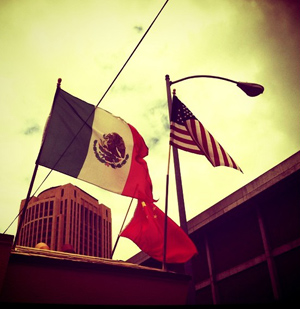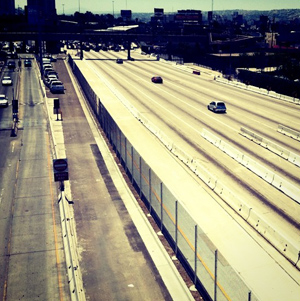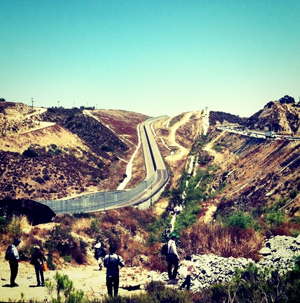Rethinking the Border
Political Equator 3 project takes creative approach to addressing San Diego-Tijuana border region issues
Tiffany Fox | May 31, 2011

Photos by Benjamin Lotan
It’s at once an informal settlement, a military installation and a vulnerable environmental zone. It’s also one of the world’s great creative urban laboratories and what former U.N. diplomat and UC San Diego Urban Studies and Planning lecturer Oscar Romo calls “the very edge of the developed and the underdeveloped world.”
The San Diego-Tijuana International border region was the focus last week of a two-day “nomadic conversation” known as Political Equator 3, the third program in a series of binational conferences co-organized by the UCSD’s Center for Urban Ecologies and two community-based, non-profit organizations on both sides of the border. The event—which brought together a group of about 125 leaders, dignitaries, artists and academics from around the world—combined a series of public walks and discussions and culminated in a performance piece that Romo described as “not exactly breaking the law, but completely irrational” to enforcers both north and south of the border.
Clutching their passports, about 80 of the participants traversed the border through a muddy drainage culvert from San Diego to Tijuana on Saturday, marking the first time that Mexico has designated a drain as an officialport of entry.
With 47,000 people and up to 80,000 cars traversing it every day, the San Diego-Tijuana International Border is the busiest in the world, and a region challenged by shifting global dynamics, dwindling natural resources and the sometimes conflicting needs of marginal communities, said UCSD’s Teddy Cruz. Cruz who helped conceptualize, co-organize and produce the conference, is an associate professor in public culture and urbanism in the university’s visual arts department and is recognized internationally for his urban research of the Tijuana- San Diego border.

In a slide presentation during Day One of the event Friday, Cruz introduced the idea of a solar-powered Hummer as a symbol for the way policymakers and political leaders have ‘camouflaged’ the social, economic and environmental problems of the border region. He called #PE3 (as it was known to its Twitter-savvy audience) an invitation to “re-think the politics and economics of growth to look at neighborhoods as sites of cultural, social and economic production” and also a moment to “reclaim the artist as an enabler, an interlocuter... in a discussion that is de-centered from the university and brought to the community.”
It was also an opportunity to, as architect and PE3 participant Emiliano Gandolfi put it, “attempt to effect change without buying into established rules.”
Cruz and others noted that this approach to urban and community development is already being modeled by Casa Familiar, one of the co-organizers of PE3 and a bastion for community development and social justice in the San Ysidro community. Casa Familiar CEO Andrea Skorepa and other representatives from the non-profit organization led the PE3 participants on a tour of the multi-block neighborhood west of I-5 and just north of San Ysidro Avenue that has been transformed through its adult and youth services, property development and affordable housing projects, which include “Living Rooms at the Border” and “Senior Housing with Childcare.” Both projects were featured in the New York Museum of Modern Art’s recent exhibition, “Small Scale, Big Change: New Architectures of Social Engagement.”
Skorepa noted that the site of the PE3 orientation itself—a two-story mixed-use building known as The Front—has mirrored San Ysidro’s growth, transforming from a small grocery store to a smog shop to its current incarnation: A high-tech art gallery and performance space equipped with a mobile, networked tiled display known as an OptIPortable. The OptIPortable was provided by the UCSD division of the California Institute for Telecommunications and Information Technology (Calit2) and will enable organizers at Casa Familiar to collaborate with academic and commercial centers without leaving their own neighborhood.

The second day of PE3 explored the implications of a surveillance infrastructure recently constructed by the U.S. Department of Homeland Security within the Tijuana River Estuary, as well as informal settlements that abut the delicate ecosystem, such as those in Los Laureles Canyon (which is home to approximately 85,000 squatters). PE3 organizers say the estuary has been increasingly eroded and polluted by activities on both sides of the border, prompting the need to “re-imagine the border through the logic of natural and social systems.”
Alter Terra, a community-based non-governmental organization and one of the co-organizers of PE3, has conducted scientific research for several years about the impact of the area’s human inhabitants and the construction of the new border fence. The last stop in PE3’s nomadic conversation was a visit to Alter Terra’s field station, where Cruz and Romo led discussions on “Micro-Basins as Neighborhoods” and “The Politics of Waste.”
“There’s nothing like it in the world,” said Romo about the border. “On one side of the border you have Roman law, on the other side, the law of the commons. These are two cultures that clash, but also merge, two cultures where conditions of social and economic emergency are inspiring new ways of thinking.”

|